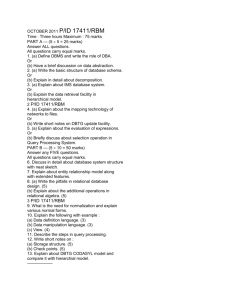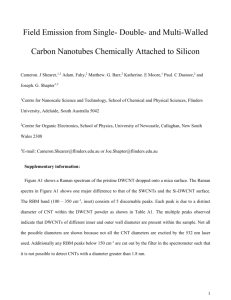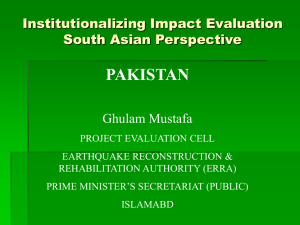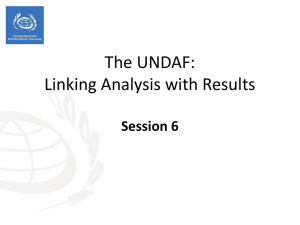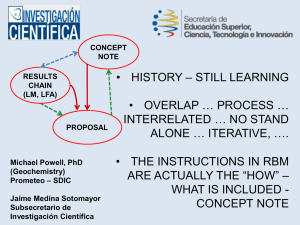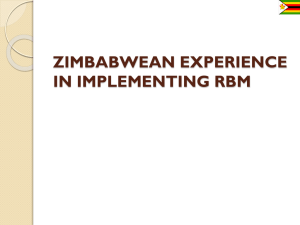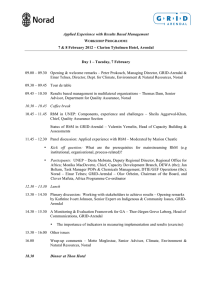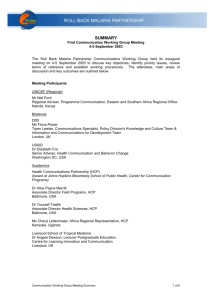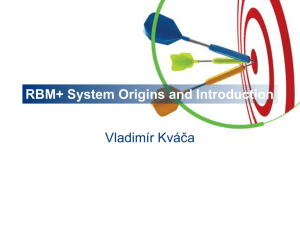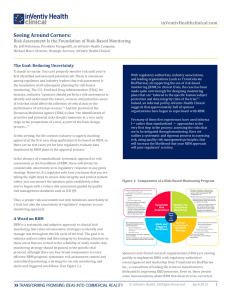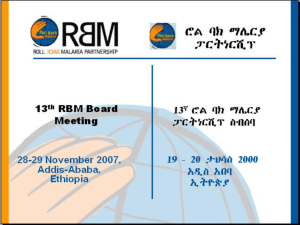For info - Community of Practice on Results Based Management
advertisement
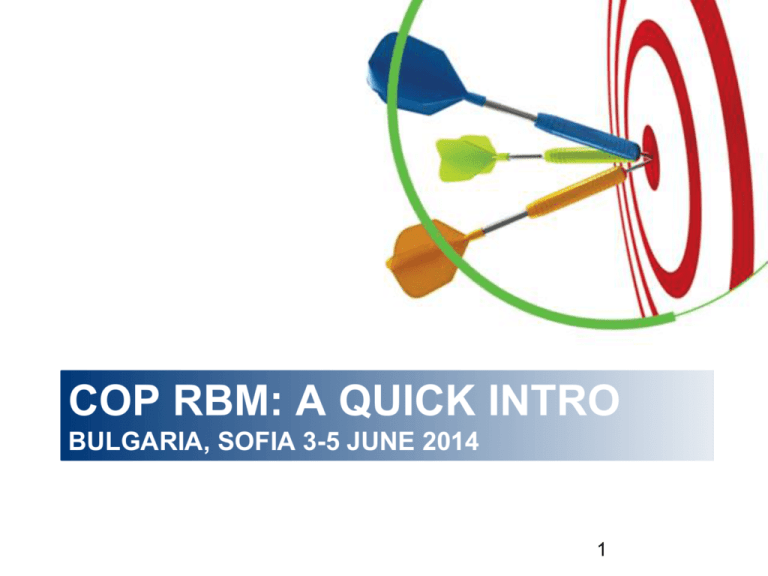
COP RBM: A QUICK INTRO BULGARIA, SOFIA 3-5 JUNE 2014 1 The Community of Practice on Results Based Management • • • Established in 2009 by a group of European Social Fund‘s Managing Authorities and associated partners, with support of European Commission. They wanted to find a better way how to manage public funds like ESF/ERDF The network developed the „Results Based Management System Plus“ based on reviews of existing frameworks, scientific research and own experience: In principle, RBM+ deals adequately with all these major frameworks: no need to use and reconcile these yourself anymore • Today we represent 8 countries with 12 core partners as well as a variety of associate partners • Its longer term vision focuses on using ESF/ERDF as leverage to improve the functioning of the public service in general • New Zealand: Getting Better at Managing for Outcomes and Getting Better at Managing for Shared Outcomes • Treasure Board of Canada: The Managing for Results Self-Assessment Tool • World Bank: CAP-Scan Managing for Development Results Capacity Scan • Asian Development Bank: Readiness Assessment Tool - Implementing a Results Focus in Organizations • EIPA: CAF • Palladium: Balanced Scorecard Hall of Fame award for Executing Strategy The Community of Practice on Results Based Management • • • Established in 2009 by a group of European • New Zealand: Getting Better Social Fund‘s Managing Authorities and at Managing for Outcomes associated partners, with support of European and Getting Better at Commission. Managing for Shared Outcomes They wanted to find a better way how to manage • Treasure Board of Canada: public funds like ESF/ERDF See www.coprbm.eu for The Managing for Results The network developed the „Results Based Self-Assessment Tool more! Management System Plus“ based on reviews of • World Bank: CAP-Scan existing frameworks, scientific research own Become anand associate Managing for Development experience: Results Capacity Scan partner and gain access• Asian to Development Bank: Assessment Tool more resources! Readiness - Implementing a Results In principle, RBM+ deals adequately with all these major frameworks: no need to use and reconcile these yourself anymore • • Today we represent 8 countries with 12 core partners as well as a variety of associate partners Its longer term vision focuses on using ESF/ERDF as leverage to improve the functioning of the public service in general Focus in Organizations • EIPA: CAF • Palladium: Balanced Scorecard Hall of Fame award for Executing Strategy COP RBM focus Corporate strategy for a diversified conglomerate Business 1 Business 2 Business 3 • Growth strategy = what new business • Portfolio management = where to invest / divest in existing businesses? • Parenting = how to coordinate and share resources between businesses? National/regional/local policy MacroFunctioning of democracy economic policy Transport Separation Education Balanced of powers Sectors Health Judiciary ... Rule of law … Budget allocation (performance budgeting) budget Sound fiscal policy Infrastructure Level playing field (competition) … Businesses, organisations, agencies and their performance in delivering services = COP RBM focus 4 COP RBM longer term vision • • • • The network partners have ignited an energetic movement of reform throughout the European Structural Funds. Fund leadership and their staff are focused on key organizational and societal outcomes. They are also highly attuned to their external environment, aware of emerging threats and opportunities and ready to act upon these swiftly. There is a common understanding that change primarily takes root when it involves broad sets of actors engaged together in designing and implementing locally relevant solutions to locally perceived problems, in the public service and in society in general. Collaboration, inviting feed-back, using information purposefully, deliberation, respecting diversity and taking responsibility constitute the core of Fund management. This is reinforced actively at all levels by a highly committed leadership. Leading by example, the Funds are actively engaged in stimulating more widespread reform of the public service throughout Europe, at all levels, including the European one. They are acknowledged as centres of excellence in this field. Due to this effort, the public sector matches the capacity of the private and nongovernmental sectors to perform, innovate and change. It is seen by citizens as being responsive, pro-active and supportive. It is government “with” citizens rather than “for” citizens, therefore strengthening their resilience. 5 COP RBM strategy EU ESIF org. COP Coordination ESIF entities need to lead by example, which includes taking up proper processes to facilitate meaningful public reform elsewhere Other public actors Other public actors ESIF org. ESIF org. ESIF org. Other public actors Citizens (incl. entrepreneurs) Other public actors 6 CULTURAL ANTROPOLOGY DEVELOPMENTAL / SOCIAL PSYCHOLOGY Biology/ ecology • • • • • • SOCIOLOGY SYSTEMS THINKING APPROACH System and sub-systems in a hierarchy Interactions give rise to emergent properties Interactions define boundaries with wider systems Wider systems represent the environment Systems must develop productive relations with their environment Resilience of systems • • • • Control engineering (quality) Negative feed-back: dampening divergence of behaviour from a goal Positive feed-back: amplifying deviation from a goal (for better or worse) The many relations between the part of a system give rise to interacting positive and negative feed-back loops leading to unpredictabilty Requisite variety RBM Tools RBM »plus » Complexity theory • • • • • Attractors Non-linearity Self-organisation Emergence Path dependency Behavioral economics ECONOMICS • Routines (collective), habits (individual), rules norms • Power • Biases Institutional/ evolutionary economics NPM approach Rational choice theory 7 CULTURAL ANTROPOLOGY DEVELOPMENTAL / SOCIAL PSYCHOLOGY Biology/ ecology • • • • • • SOCIOLOGY SYSTEMS THINKING APPROACH System and sub-systems in a hierarchy Interactions give rise to emergent properties Interactions define boundaries with wider systems Wider systems represent the environment Systems must develop productive relations with their environment Resilience of systems • • • • Control engineering (quality) Negative feed-back: dampening divergence of behaviour from a goal Positive feed-back: amplifying deviation from a goal (for better or worse) The many relations between the part of a system give rise to interacting positive and negative feed-back loops leading to unpredictabilty Requisite variety RBM Tools RBM »plus » Complexity theory • • • • • Attractors Non-linearity Self-organisation Emergence Path dependency Behavioral economics ECONOMICS • Routines (collective), habits (individual), rules norms • Power • Biases Institutional/ evolutionary economics NPM approach Rational choice theory 8 Different concepts of accountability • “honest and fair”: traditional view dating back to Weberian bureaucracy focus is on preventing distortion, bias, abuse of office and inequity proper discharge of duties in terms of procedures AND substance is of prime importance: • “how the job gets done” rather than just “getting the job done with the least possible input” emanations: • process controls (rather than output) • words like transparency, prevention and detection of fraud, compliance with rules, etc. fit here 9 Accountability for what? Different concepts of accountability • “lean and purposeful”: This view rises with New Public Management match narrowly defined tasks and circumstances with resources (time and money) as tightly as possible, cutting any slack it is very important to have “checkable” objectives that are not overlapping hence the focus on outputs, ideally to be provided by independent departments emanations: • words like effectiveness, efficiency, impact, value for money, achieving targets • approaches like payment by results, just in time delivery and zero based budgeting 11 Accountability for what? 12 Different concepts of accountability • “robust, resilient, adaptive”: „post – NPM“ redirection of attention to complex nature of society focus is on being able to withstand shocks, to keep operating even under the most dire circumstances and to adapt rapidly in a crisis emanations: • back-up systems, maintaining adequate diversity to avoid widespread common failure (including in the social sense e.g. avoiding groupthink) and building in safety margins (e.g. in planning work or using materials) • words like diversity, empowerment, sustainability etc. 13 Accountability for what? 14 For info Hood (1991) What happens if we do not find a balance? Private sector examples of overemphasising lean and purposeful (facilitated by public policy) with wider repercussions 16 New Synthesis approach • Public management is a balancing act: Lean and purposeful in terms of performance: • “traditional” results (outputs, outcomes) • civic results in terms of the use of power: • government • collective • …underpinned by the three notions of accountability Honest and fair J. Bourgon, A new synthesis for public administration Robust, resilient,.. Performance and accountability are two faces of the same coin! LEAN AND PURPOSEFUL capacity for organisational performance to deal with reasonably predictable (in/frequent) demands, that may exhibit great variation HONEST AND FAIR capacity to comply to ensure fairness capacity to adapt in order to be able to respond as quickly as possible to anything as ROBUST, RESILIENT, ADAPTIVE yet unforeseeable capacity for innovation to deal with a range of as yet uncertain but plausible demands 27 Results Based Management • an organization should be ready to respond to changes in circumstances or performance and alter one’s approach if necessary, which requires… Demand orientation Focus on the system as a whole an analytical and performance-oriented approach to understanding what to do; a view of performance that is centred on beneficiary level outcomes; only thereafter moving toward identifying what resources, actions and outputs are necessary to get there; a need for information about the subject and a capacity to collect, process and analyse this information over time; a mechanism by which policy, planning and decision-making can be influenced by performance information. Source: REVIEW: RESULTS BASED MANAGEMENT IN DEVELOPMENT COOPERATION by the Riksbankens Jubileumsfond synthesised in the COP RBM Sourcebook ch. 3.3 Six core RBM practices • 1. Orientation of the organisation is clear • 2. The organisational strategy is reflected in a strategic results framework • 3. The strategy is translated into operations • 4. Performance information is collected and supplied • 5. Performance information is used • 6. External stakeholders are involved in all aspects 29 We have tools and approaches for all these steps But where to start? Where are the opportunities? What can be meaningful next steps? 30 Vision, strategy and operations • When current operations are a struggle, with a great deal of pressure, … • … then vision/strategy becomes a vision/strategy of survival: fighting fires everyday, maintaining basic services! • This reaffirms the importance of a deep understanding of your current operations before anyhting else: • if daily work life is a struggle for survival… • …then senior managers coming along with wonderful statements about vision, mission and values are bound to be seen as coming from another planet • we call it the Mr Spock (‘live long and prosper’) syndrome 31 Toyota Production System for services = Vanguard approach 32 RBM “plus” is about management innovation Stages in adoption Online training 1. Knowledge: requires… Awareness of the innovation • Trigger to get two other kinds of knowledge How and why it works • Influences attitudes How to use it correctly • Critical for trials and hence for complex innovations 2. Persuasion: requires… Standard 3 day seminars Action learning (by doing) engagements Social reinforcement of others, particularly close peers subjective assessments (more than experts, science) Perceived characteristics 3. Decision: requires… Possibility to try innovation in own situation Social reinforcement dynamic YOU IPA, OPAC, COP RBM… • • Innovators - These are people who want to be the first to try the innovation. They are venturesome and interested in new ideas. These people are very willing to take risks, and are often the first to develop new ideas. Very little, if anything, needs to be done to appeal to this population. They can bring in the new ideas first, but they are rarely widely respected leaders but tend to be “technicians” who have complex technical knowledge. Early Adopters - These are people who represent opinion leaders. They enjoy leadership roles, and embrace change opportunities. They are already aware of the need to change and so are very comfortable adopting new ideas. Strategies to appeal to this population include how-to manuals/trainings and information sheets on implementation. They do not need information to convince them to change. THEY reduce uncertainty for others. What parts of the RBM+ system to focus on? • • • • • Relative advantage: Prevention (averting unwanted futures) less quick to be adopted than when need is acute and benefits are therefore quick Includes also social status aspect for innovators and early adopters Compatibility: With existing values, past experiences, needs of adopters Complexity: Difficulty of understanding and using Trialability: Can it be piloted on a limited basis? Very important for early adopters! Very important for complex innovations! Observability: Start with “TPS for Degree to which results are visible to others services” • Ever heard the term “learning organisations”? “All real change is grounded in new ways of thinking and perceiving” * Peter Michael Senge is an American scientist and director of the Center for Organizational Learning at the MIT Sloan School of Management. He is known as author of the book The Fifth Discipline: The art and practice of the learning organization from 1990 (new edition 2006). He is a senior lecturer at the System Dynamics Group at MIT Sloan School of Management, and co-faculty at the New England Complex Systems Institute. In 1997, Harvard Business Review identified The Fifth Discipline as one of the seminal management books of the previous 75 years. For this work, he was named by Journal of Business Strategy as the 'Strategist of the Century'. They further said that he was one of a very few people who 'had the greatest impact on the way we conduct business today'. * P. Senge, The necessary revolution, p.10 37 • This is NOT just some technical seminar, where you get to learn some tools and techniques (well, you also get those) • It is also about LEADERSHIP! YOU 38 • This is NOT just some technical seminar, where you get to learn some tools and techniques (well, you also get those) • It is also about LEADERSHIP! YOU 39 • We want you to reflect critically during the engagement… Does what you are being told make any sense, in your context, at this time… Does the way it is being brought to you make any sense… • We want you to EXPRESS these concerns so we can also understand better what does and does not make sense • We need to be aware there are cultural differences at play that, if unrecognised, can seriously hamper learning from each other 40 Power distance expresses the degree to which the less powerful members of a society accept and expect that power is distributed unequally. Societies exhibiting a large degree of power distance accept a hierarchical order in which everybody has a place and which needs no further justification. In societies with low power distance, people strive to equalise the distribution of power and demand justification for inequalities of power. http://geerthofstede.co m/bulgaria.ht ml „The uncertainty avoidance „Individualism is a preference for a dimension expresses the degree loosely-knit social framework in to which the members of a which individuals are expected to society feel uncomfortable with take care of themselves and their uncertainty (the fact that the immediate families only. Its future can never be known) and opposite, Collectivism, ambiguity: should we try to represents a preference for a control the future or just let it tightly-knit framework in society happen? Strong UA = more in which individuals can expect rigid codes of belief and their relatives or members of a behaviour and more intolerant particular in-group to look after of unorthodox behaviour and them in exchange for ideas. Weak UA = a more unquestioning loyalty. This is relaxed attitude in which practice reflected in whether people’s selfcounts more than principles. image is defined in terms of “I” or “we.” Bulgaria 70 85 30 The masculinity side represents a preference for achievement, heroism, assertiveness and material reward for success. Society at large is more competitive. Its opposite, femininity, stands for a preference for cooperation, modesty, caring for the weak and quality of life. Society at large is more consensusoriented. 40 Belgium Great Britain 35 35 89 66 41 • I wish you a great learning journey! • Benedict.wauters@esf.vlaanderen.be 42
